
The geometer moths are moths belonging to the family Geometridae of the insect order Lepidoptera, the moths and butterflies. Their scientific name derives from the Ancient Greek geo γεω, and metron μέτρον "measure" in reference to the way their larvae, or inchworms, appear to measure the earth as they move along in a looping fashion. A very large family, it has around 23,000 species of moths described, and over 1400 species from six subfamilies indigenous to North America alone. A well-known member is the peppered moth, Biston betularia, which has been subject of numerous studies in population genetics. Several other geometer moths are notorious pests.
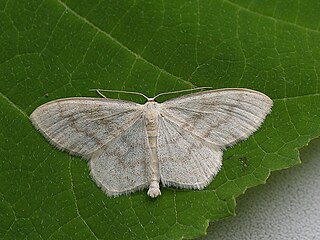
The cream wave is a moth of the family Geometridae. The species was first described by Adrian Hardy Haworth in 1809. It is found in forest and woodland regions, feeding on grasses and small plants such as dandelion.

Scopula immorata, the Lewes wave, is a moth of the family Geometridae. It is found throughout Europe and the Near East.

Scopula immutata, the lesser cream wave, is a moth of the family Geometridae. It was described by Carl Linnaeus in his 1758 10th edition of Systema Naturae. It is found throughout Europe.
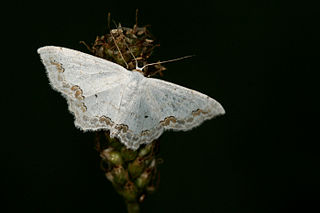
Scopula ornata, the lace border, is a moth of the family Geometridae. The species was first described by Giovanni Antonio Scopoli in his 1763 Entomologia Carniolica. It is found in Europe, North Africa and the Near East.

Scopula cacuminaria, the frosted tan wave, is a moth of the family Geometridae. The species was first described by Herbert Knowles Morrison in 1874. It is found in North America across southern Canada, from the Maritimes to southern British Columbia, south to Texas.

Scopula incanata is a species of moth in the family Geometridae. It is found from north-eastern Europe and the Caucasus to southern Siberia and northern Mongolia.

Scopula virgulata, the streaked wave, is a moth of the family Geometridae. The species was first described by Denis & Ignaz Schiffermüller in 1775. It is found from most of Europe to central Asia and northern Mongolia.

Scopula emutaria, the rosy wave, is a species of moth in the family Geometridae. It is found in western and south-western Europe and Romania. Also in North Africa.
Scopula asellaria is a moth of the family Geometridae. It was described by Gottlieb August Wilhelm Herrich-Schäffer in 1847. It is found in southern Europe and North Africa.
Scopula confinaria is a moth of the family Geometridae. It is found in southern Europe, southern Russia and Turkey.
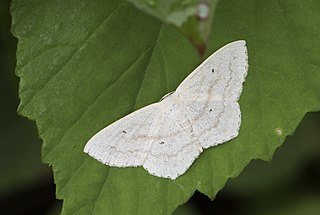
Scopula flaccidaria is a moth of the family Geometridae. It was described by Zeller in 1852. It is found in the Asia Minor, Russia and south-eastern Europe.

Scopula nemoraria is a moth of the family Geometridae. It is found from central to eastern Europe, east to Russia and China.

Scopula submutata, the Mediterranean lace border, is a moth of the family Geometridae. It is found in southern Europe, North Africa and the Near East. The habitat consists of open, dry grassland and rocky slopes.
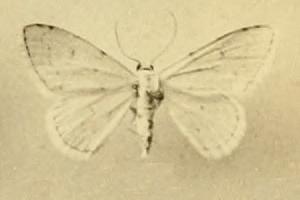
Scopula sacraria is a moth of the family Geometridae. It is found on Cyprus and the European part of Russia.
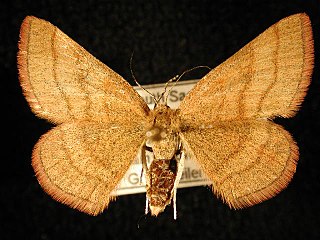
Scopula sentinaria is a moth of the family Geometridae. It is found from Alaska to Labrador, south in the prairies to southern Manitoba, Saskatchewan, Alberta and British Columbia. In the mountains it ranges south to Colorado. The species is also found in northern Russia and the Sayan Mountains. The habitat consists of dry shrubby clearings and edges.

Scopula turbulentaria, the dotted ochre wave, is a moth of the family Geometridae. It is found in southern Russia, Albania, Romania, Greece, North Macedonia and Italy and on Sardinia, Sicily, Crete, Cyprus, as well as in Turkey.

Scopula caricaria is a moth of the family Geometridae. It is found in Spain, Italy, France, Liechtenstein, Germany, Austria, Switzerland, Poland, the Czech Republic, Slovakia, Hungary, Romania, Slovenia, Croatia, Bosnia and Herzegovina, Finland, Estonia, Latvia, north-western Russia, Belarus and Ukraine.
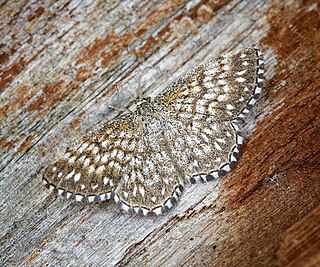
Scopula tessellaria, the dusky-brown wave, is a moth of the family Geometridae. It is found in Belgium, Luxembourg, France, Germany, Italy, Spain, Albania, former Yugoslavia, Croatia, Bulgaria, Romania, North Macedonia, Greece, Moldova, Ukraine and Russia. In the east, the range extends to the Near East and the eastern part of the Palaearctic realm.

Scopula umbelaria is a moth of the family Geometridae described by Jacob Hübner in 1813. It is found in the Benelux, France, Italy, Germany, Switzerland, Austria, the Czech Republic, Slovakia, Hungary, Slovenia, former Yugoslavia, Romania, Poland and Russia. In the east, the range extends to the eastern part of the Palearctic realm.

















